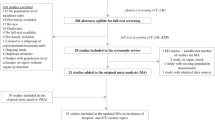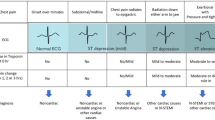Abstract
Background
Guidelines recommend high-sensitivity cardiac troponin (hs-cTn) for diagnosis of myocardial infarction. Use of hs-cTn is increasing across the U.S., but questions remain regarding clinical and operational impact. Prior studies have had methodologic limitations and yielded conflicting results.
Objective
To evaluate the impact of transitioning from conventional cardiac troponin (cTn) to hs-cTn on test and resource utilization, operational efficiency, and patient safety.
Design
Retrospective cohort study in two New York City hospitals during the months before and after transition from conventional cTn to hs-cTn at Hospital 1. Hospital 2 served as a control.
Participants
Consecutive emergency department (ED) patients with at least one cTn test resulted.
Intervention
Multifaceted hs-cTn intervention bundle, including a 0/2-h diagnostic algorithm for non-ST-elevation myocardial infarction, an educational bundle, enhancements to the electronic medical record, and nursing interventions to facilitate timed sample collection.
Main Measures
Primary outcomes included serial cTn test utilization, probability of hospital admission, ED length of stay (LOS), and among discharged patients, probability of ED revisit within 72 h resulting in hospital admission. Multivariable regression models adjusted for age, sex, temporal trends, and interhospital differences.
Key Results
The intervention was associated with increased use of serial cTn testing (adjusted risk difference: 48 percentage points, 95% CI: 45–50, P < 0.001) and ED LOS (adjusted geometric mean difference: 50 min, 95% CI: 50–51, P < 0.001). There was no significant association between the intervention and probability of admission (adjusted relative risk [aRR]: 0.99, 95% CI: 0.89–1.1, P = 0.81) or probability of ED revisit within 72 h resulting in admission (aRR: 1.1, 95% CI: 0.44–2.9, P = 0.81).
Conclusions
Implementation of a hs-cTn intervention bundle was associated with an improvement in serial cTn testing, a neutral effect on probability of hospital admission, and a modest increase in ED LOS.


Similar content being viewed by others
Data Availability
The datasets generated and analyzed during the current study are available from the corresponding authors on reasonable request.
References
Kontos MC, de Lemos JA, Deitelzweig SB, et al. 2022 ACC Expert Consensus Decision Pathway on the Evaluation and Disposition of Acute Chest Pain in the Emergency Department: A Report of the American College of Cardiology Solution Set Oversight Committee. J Am Coll Cardiol. 2022;80(20):1925-1960.
Collet JP, Thiele H, Barbato E, et al. 2020 ESC Guidelines for the management of acute coronary syndromes in patients presenting without persistent ST-segment elevation. Eur Heart J. 2021;42:1289-1367.
Sandoval Y, Apple FS, Mahler SA, Body R, Collinson PO, Jaffe AS. High-Sensitivity Cardiac Troponin and the 2021 AHA/ACC/ASE/CHEST/SAEM/SCCT/SCMR Guidelines for the Evaluation and Diagnosis of Acute Chest Pain. Circulation. 2022;146:569-581.
Gulati M, Levy PD, Mukherjee D, et al. 2021 AHA/ACC/ASE/CHEST/SAEM/SCCT/SCMR Guideline for the Evaluation and Diagnosis of Chest Pain: A Report of the American College of Cardiology/American Heart Association Joint Committee on Clinical Practice Guidelines. Circulation. 2021;144:e368-e454.
McCarthy C, Li S, Wang TY, et al. Implementation of High-Sensitivity Cardiac Troponin Assays in the United States. J Am Coll Cardiol. 2023;81(3):207-219.
Yang HS, Shemesh A, Li J, et al. No increase in the incidence of cardiac troponin I concentration above the 99th percentile by Siemens Centaur high-sensitivity compared to the contemporary assay. Clin Biochem. 2021;89:77-80.
Khan E, Lambrakis K, Nazir SA, et al. Implementation of more sensitive cardiac troponin T assay in a state-wide health service. Int J Cardiol. 2022;347:66-72.
Peck D, Knott J, Lefkovits J. Clinical impact of a high-sensitivity troponin assay introduction on patients presenting to the emergency department. Emerg Med Australas. 2016;28:273-8.
Greenslade JH, Parsonage W, Foran L, et al. Widespread Introduction of a High-Sensitivity Troponin Assay: Assessing the Impact on Patients and Health Services. J Clin Med. 2020;9(6):1883.
Jülicher P, Greenslade JH, Parsonage WA, Cullen L. The organisational value of diagnostic strategies using high-sensitivity troponin for patients with possible acute coronary syndromes: a trial-based cost-effectiveness analysis. BMJ Open. 2017;7:e013653.
Roos A, Holzmann MJ. Healthcare and Resource Use in Patients With Stable High-Sensitivity Cardiac Troponin T Levels. Am J Cardiol. 2020;128:67-74.
Anand A, Lee KK, Chapman AR, et al. High-Sensitivity Cardiac Troponin on Presentation to Rule Out Myocardial Infarction: A Stepped-Wedge Cluster Randomized Controlled Trial. Circulation. 2021;143:2214-2224.
Ambavane A, Lindahl B, Giannitsis E, et al. Economic evaluation of the one-hour rule-out and rule-in algorithm for acute myocardial infarction using the high-sensitivity cardiac troponin T assay in the emergency department. PLoS One. 2017;12:e0187662.
Conway R, Byrne D, Cournane S, O'Riordan D, Coveney S, Silke B. Is there excessive troponin testing in clinical practice? Evidence from emergency medical admissions. Eur J Intern Med. 2021;86:48-53.
Johannessen TR, Halvorsen S, Atar D, et al. Cost-effectiveness of a rule-out algorithm of acute myocardial infarction in low-risk patients: emergency primary care versus hospital setting. BMC Health Serv Res. 2022;22:1274.
Ford JS, Chaco E, Tancredi DJ, Mumma BE. Impact of high-sensitivity cardiac troponin implementation on emergency department length of stay, testing, admissions, and diagnoses. Am J Emerg Med. 2021;45:54-60.
Suh EH, Tichter AM, Ranard LS, et al. Impact of a rapid high-sensitivity troponin pathway on patient flow in an urban emergency department. J Am Coll Emerg Physicians Open. 2022;3:e12739.
Bevins NJ, Chae H, Hubbard JA, et al. Emergency Department Management of Chest Pain With a High-Sensitivity Troponin-Enabled 0/1-Hour Rule-Out Algorithm. Am J Clin Pathol. 2022;157:774-780.
Ola O, Akula A, Michieli LD, et al. Clinical Impact of High-Sensitivity Cardiac Troponin T Implementation in the Community. J Am Coll Cardiol. 2021;77:3160-3170.
Younis A, Farooq S, Bisognano JD, et al. Outcomes Associated with Introduction of the 5(th) Generation High-Sensitivity Cardiac Troponin in Patients Presenting with Cardiovascular Disorders. J Emerg Med. 2022;62:657-667.
Tomaszewski CA, Nestler D, Shah KH, Sudhir A, Brown MD. Clinical Policy: Critical Issues in the Evaluation and Management of Emergency Department Patients With Suspected Non-ST-Elevation Acute Coronary Syndromes. Ann Emerg Med. 2018;72:e65-e106.
Fischer BG, Evans AT. High-Sensitivity Cardiac Troponin Algorithms and the Value of Likelihood Ratios. J Gen Intern Med. 2023;38(9):2189-2193.
Rohrer JM. Thinking clearly about correlations and causation: Graphical causal models for observational data. Advances in Methods and Practices in Psychological Science. 2018;1:27-42.
Polubriaginof FCG, Ryan P, Salmasian H, et al. Challenges with quality of race and ethnicity data in observational databases. J Am Med Inform Assoc. 2019;26:730-736.
Chartier LB, Ovens H, Hayes E, et al. Improving Quality of Care Through a Mandatory Provincial Audit Program: Ontario's Emergency Department Return Visit Quality Program. Ann Emerg Med. 2021;77:193-202.
Rising KL, Karp DN, Powell RE, Victor TW, Carr BG. Geography, Not Health System Affiliations, Determines Patients' Revisits to the Emergency Department. Health Serv Res. 2018;53:1092-1109.
Shy BD, Loo GT, Lowry T, et al. Bouncing Back Elsewhere: Multilevel Analysis of Return Visits to the Same or a Different Hospital After Initial Emergency Department Presentation. Ann Emerg Med. 2018;71:555-563.e1.
Acknowledgements:
We thank Arthur T. Evans, MD, MPH (Weill Cornell Medicine) for his invaluable guidance in developing the statistical analysis plan and Patrick Rumble, BS (Weill Cornell Medicine), for his instrumental assistance in data acquisition.
Author information
Authors and Affiliations
Corresponding authors
Ethics declarations
Conflict of Interest:
LW is pending a patent for “Methods for detecting and treating endometriosis” Publication number: 20210096137. JS had a registration fee waived as a speaker at XGM Conference May 2023 and is the Co-Chair of the didactics Sub-committee for the Society of Academic Emergency Medicine 2022–2023 (unpaid). RJK has stock options in Cleerly Health, Inc. AC has received consulting fees from Leica Biosystems (Immunohistochemistry) and Boehringer-Ingelheim (hematopoietic neoplasms) and lecture fees at McGill University, Medical College of Wisconsin, and Northshore University Hospital (Evanston, IL). HSY received a speaker fee from Siemens Healthineers. PADS received consulting fees for ET health, speaker fees for the American College of Emergency Physicians Directors Academy, and is on the David Lynch Foundation National Advisory Board. ZZ has sponsored research supported by Novartis, Waters, Siemens Healthineers, Polymedco, Waters, Roche and ET Healthcare and has received consulting/speaker fee from Siemens Healthineers, Roche and ET Healthcare.
Additional information
Publisher's Note
Springer Nature remains neutral with regard to jurisdictional claims in published maps and institutional affiliations.
Supplementary Information
Below is the link to the electronic supplementary material.
Rights and permissions
Springer Nature or its licensor (e.g. a society or other partner) holds exclusive rights to this article under a publishing agreement with the author(s) or other rightsholder(s); author self-archiving of the accepted manuscript version of this article is solely governed by the terms of such publishing agreement and applicable law.
About this article
Cite this article
Warren, L., Fischer, B.G., Shemesh, A. et al. Improved Utilization of Serial Testing Without Increased Admissions after Implementation of High-Sensitivity Troponin I: a Controlled Retrospective Cohort Study. J GEN INTERN MED 39, 739–746 (2024). https://doi.org/10.1007/s11606-023-08535-3
Received:
Accepted:
Published:
Issue Date:
DOI: https://doi.org/10.1007/s11606-023-08535-3




